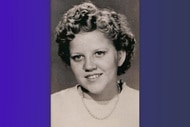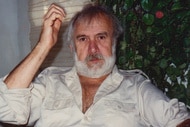Create a free profile to get unlimited access to exclusive videos, breaking news, sweepstakes, and more!
Cold Case Murder Of Las Vegas Teen Kim Bryant Solved After 42 Years
Newly re-analyzed DNA evidence helped authorities identify the likely murder suspect in the decades-old unsolved rape and murder.

The cold case slaying of a Nevada teenager whose body was found in the desert in 1979 was solved after DNA evidence pinpointed her suspected murderer, police said.
On Monday, officials announced they’d identified a suspect in the previously unsolved killing of 16-year-old Kim Bryant, who was sexually assaulted and killed more than four decades ago.
Bryant was last seen alive at a Dairy Queen restaurant near North Decatur Boulevard and U.S. Highway 95 on Jan. 26, 1979. Her family later reported her missing after she failed to come home from school.
Her body was found several weeks later in a desert-area in northwest Las Vegas; law enforcement said the Nevada teen had been sexually assaulted.
Authorities now suspect Johnny Blake Peterson, who died in 1993, was behind the decades-old murder. Homicide investigators say Peterson, who was 19 at the time of Bryant’s death, kidnapped her on the day she disappeared, and later raped and killed her.
“His identification serves as a reminder to the families of murder victims that the LVMPD will not stop investigating these crimes no matter how much time has passed,” the Las Vegas Metropolitan Police Department said in a statement Monday.
Bryant and Peterson both attended Western High School, police said. Peterson, however, wasn’t a student there at the time of Bryant’s slaying.
"Kim was a beautiful girl with a bright future, and it makes me happy that something is being done to help solve cases such as hers," Edward Elliot, Bryant’s father, wrote in a prepared statement read aloud by investigators at Monday’s press briefing, NBC News reported.
For decades, Bryant’s murder baffled investigators. Despite numerous leads — and potential suspects — no arrests were ever made in the teenager’s killing.
Years ago, forensic experts developed a DNA profile of Bryant’s possible killer, using semen that was recovered from the crime scene. However, investigators again hit a brick wall when the extracted genetic material didn’t land any matches when run through police DNA databases.
In August 2021, Las Vegas Metropolitan Police Department homicide investigators contracted Texas DNA lab Othram Inc., a private Texas-based DNA laboratory, to perform advanced genetic testing on DNA derived from the suspected killer’s semen.
“We took this profile and did a number of things, including a genealogical search, that allowed us to identify ever-so distant relatives,” Dr. David Mittelman, the Chief Executive Officer of Othram Inc., told Oxygen.com on Tuesday. “And with a lot of distant relatives, we were able to piece back together through public records and family trees, a plausible identity for who the donor of the DNA was.”
Othram Inc. used Forensic-Grade Genome Sequencing, a novel sequencing method that the Texas lab developed, that allows geneticists to form a genealogical profile of an individual using the slightest trace quantities of DNA evidence. The next-generation method can build a DNA profile from minuscule amounts of genetic evidence, which may have deteriorated or been contaminated over time.
“Imagine you have a plate that falls on the ground, it breaks into a billion little shards and you’re like, ‘put this back together,’” Mittelman explained. “What DNA sequencing does, in a very sensitive way, is read out the letters of the DNA...We’re using it to build a representation of what makes someone uniquely identifiable.”
Weeks later, Othram Inc. turned over its findings, identifying Peterson as Bryant’s potential killer.
“It was very exciting,” Mittelman said. “The whole reason we get up in the morning to help solve these cases. It’s really our core mission.”
Nevada philanthropist and tech entrepreneur Justin Woo was also crucial in solving Bryant's murder, scientists and officials said. Woo donated $5,000 to the Las Vegas Police Department, which ultimately funded the cost of Othram Inc.’s DNA testing that broke the case wide open.
In recent months, the Las Vegas entrepreneur has donated thousands to Othram to cover the costs of genetic testing on a number of cold cases. Woo’s financial contributions previously helped authorities solve the 1989 cold case killing of 14-year-old Las Vegas teenager Stephanie Isaacson, who was fatally beaten and raped on her walk to school. Her now-suspected killer, Darren R. Marchand, died in 1995.
Advancements in DNA sequencing technology, coupled with the popularity of publicly available online ancestry databases, have aided in solving dozens of cold cases in recent years. However, a distinct lack of funding exists when it comes to law enforcement accessing and applying DNA technology, Mittelman said.
“The reasons these cases aren’t getting solved isn’t because of science — what’s left is to investigate the cases, prioritize them, and fund them,” Mittelman said. “We want to solve the backlog. The bottleneck of these cases is going to end up being money and a little bit of time for these investigators to do their job. They can’t do their job if they don’t have technology. The money enables technology and they’re able to do their job. It’s a funding problem.”
Othram Inc., whose DNA analysis also helped solve the Isaacson case, is assisting authorities with approximately a dozen other unsolved murder investigations, Mittelman said.
“The immediate reward is that we can help solve these cases and put these families back together,” he added. “These families are tortured by unsolved crime.”


























